In the beginning, there was Genesis. The first effort by Hyundai to crack the luxury market was a shock to those who thought Korean carmakers could produce little more than econoboxes. The big sedan – targeting no less formidable a competitor than the BMW 5-Series – went on to win the coveted North American Car of the Year trophy after its debut in 2008.
In hindsight, while the original Genesis sedan was unquestionably a big leap for Hyundai, it probably wasn’t quite up to its European competitors. Its design was generic, its ride was plush but hardly the stuff of a 5-Series when it came to flogging the Genesis around corners. Value pricing was a critical part of the equation – much like the original Lexus models, nearly two decades earlier.
But Hyundai’s aspirations are anything but modest. During a recent visit to the maker’s R&D center in the Seoul suburb of Namyangju, senior company officials made it clear that they’re readying a number of additional entries into the luxury segment, including an update of their full-size 7-Series fighter, the Hyundai Equus.
But first up is the second-generation Genesis sedan, which we not only got a close-up look at during our visit, but also a chance to flog around the Namyangju test track.
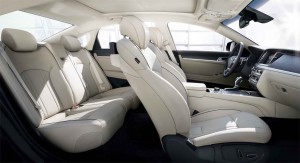
The new Genesis will deliver a much more refined interior than the old model, known as the BH internally.
“The evolved all-new Genesis is the product of Hyundai’s best resources and capabilities and we strongly believe it will be a game-changer in the market,” said Moon Sik Kwon, head of the R&D center, as the covers were pulled off the new 4-door.
The new Genesis will no longer get lost in the crowd. It picks up where the latest Hyundai Sonata left off, adds design chief Casey Hyun, introducing us to what Hyundai officials describe as the second stage in the development of their Fluidic Sculpture design language. That’s good news.
(Hyundai freshens up the Elantra. Click Here for a closer look.)
The first example of Fluidic Sculpting, if you will, certainly helped the Sonata stand out in a crowded midsize market but it bordered on an exercise in excess. The Genesis – befitting the nature of the luxury market – is a bit more subdued, with a new level of refinement to its curves and creases that will likely better stand the test of time. In Hyun’s words, the new model is “more voluptuous,” with “fewer lines and greater contrast.” That’s a fair description.
The second-generation Genesis introduces us to a new hexagonal grille which, says Hyun, will become the new face for Hyundai, in general. There are also new accent lights surrounding the now-standard HID headlamps. LEDs also are used for the fog and taillamps.
Proportions are always important in automotive design – but all the more so in the luxury segment where a maker has to justify, at first glance, the premium it’s asking from buyers. Hyundai wisely chose to go with a rear-wheel-drive platform for the original Genesis, a strategy it maintains with the 2015 model. And that layout is clearly signaled with the sedan’s long hood and cab-rearward layout. Meanwhile, the new model boasts a 3-inch longer wheelbase – though overall length is barely changed, stretching a mere 0.2 inches. That translates into significantly shorter front and rear overhangs.
One of the big surprises from the Hyundai development team was the revelation that the weight of the 2015 Genesis will be largely unchanged. We’ve been watching as maker’s try to slash mass wherever possible – from a more than 10% cut on the latest Porsche 911 to the nearly 800 pound diet for the new Range Rover Sport.
(Hyundai planning to launch new hydrogen-powered Tucson next spring. Click Here for the details.)
In the case of the new Hyundai, the decision was made to stick with steel for the new Genesis, even as the competition migrates, more and more to aluminum and other lightweight materials. That’s not all bad. The new Hyundai sedan adopts a lot more high- and ultra-high-strength steel – conveniently sourced at the Hyundai steel mill – and that translates into a significantly stiffer and crash-resistant body and platform.
The huge increase in torsional rigidity plays a major role in meeting one of Hyundai’s top targets for the new Genesis: improved steering and handling, perhaps the old car’s single biggest weaknesses – indeed, the biggest challenge for Hyundai, in general.
We were offered a brief opportunity to drive what is still a work-in-progress version of the 2015 Hyundai Genesis, and cautioned that more work needs to be done before the sedan hits the showrooms. Our initial experience was generally positive. The steering is more precise and predictable, with much more feedback than with the old model. The new Genesis was able to neatly slice around corners on a short handling track until we pushed it to its limits. There it began to reveal that more work was needed, the suspension occasionally slamming into the bump stops as we shot from one apex to another.
It’s not a 5-Series, not yet, anyway, but with a little more tweaking before its launch the new Genesis should be a credible performer.
Of course, it will help to continue with its two current powertrains, the 3.8-liter V-6 powering a rear-drive offering, the 5.0-liter V-8 available with the new Hyundai HTRAC all-wheel-drive system. The downside is that the maker is – at least for now – predicting we’ll see little improvement in fuel economy over the current Genesis line. That could disappoint potential buyers.
They’ll be a lot more pleased when they get a look at the 2015 Hyundai Genesis interior which reveals as significant a move up-market as the exterior styling. The goal is to “set the standard for all (Hyundai) vehicles to come,” explained design chief Hyun, no low benchmark to have to clear. And the new model delivers with more elegant – and intuitively placed – buttons and switches, aluminum, wood and leather accents and such details as contrasting stitching.
(Hyundai captures top spot on Total Value Index. Click Here for details.)
The back seat is particularly well-equipped, Hyundai planners noting they took in mind the fact that buyers in China are more likely than not going to be chauffeured. Nonetheless, customers in the U.S. will appreciate this detail, as well.
Practical features include an improved gauge cluster, a new heads-up display system, a standard 8-inch center stack display – which can be upgraded to 9.2 inches with the 17-speaker Lexicon premium audio package. There’s even a new SIRI voice search available for those who pair the Bluetooth system to an iPhone.
Technology has become a competitive battleground in the luxury market, and Hyundai promises to have plenty of ammunition at its disposal, including a variety of active safety systems, such as blind spot detection and Automatic Emergency Braking. It will bring the vehicle to a complete stop, if a potential crash is detected, at speeds up to 50 mph. Above that, the system will alert the driver and begin partial braking if the motorist hesitates.
Hyundai also is introducing two new features. One is a carbon dioxide sensor which, the maker suggests, can sense whether a motorist might be getting drowsy. The system will automatically vent the cabin if CO2 levels get above 2,500 parts per million.
(More luxury cars coming, says Hyundai exec. Click Here for more.)
Also on order is a new Smart Trunk system. It’s somewhat similar to the approach Ford has taken on models such as the C-Max – but you don’t have to waggle your foot under the rear bumper. The trunk will automatically pop open if you have the key fob in your pocket and stand next to it for three seconds.
Add it all up and Hyundai has big hopes for the new Genesis. The original sedan has done a lot to change perceptions of the brand, and Park Joon Hong, a researcher at the maker’s R&D center hopes the 2015 model, codenamed DH, will take things a step further.
“Hyundai cars are known for good value for money. But such perception can no longer make us competitive,” he said. The new Genesis sedan will have to stand on its own against some of the world’s toughest competitors whatever the price.

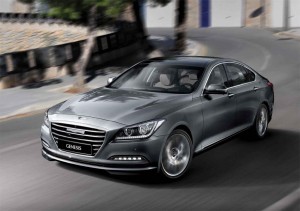
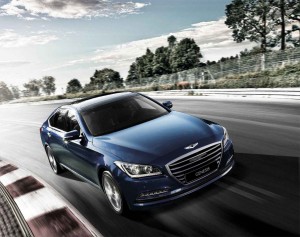
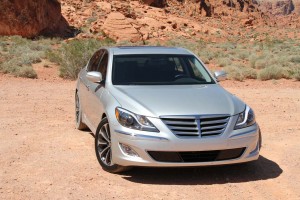
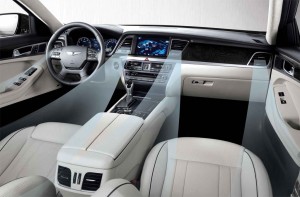
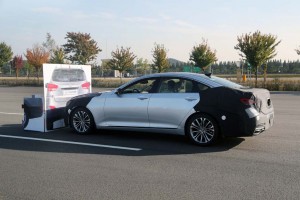
Watch out Audi! It’s payback time for Peter Schreyer.
There’s little doubt that from a styling standpoint, at least, Hyundai and Kia are very, very different companies than they were less than a decade ago.
Paul E.
Regardless of what Hyundai does, their cars will forever be known to me as bargain-basement transportation-a small step above Kia.
and Kia has their own $50K car coming out.